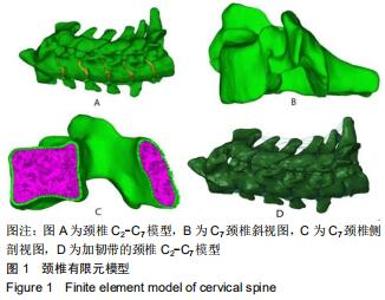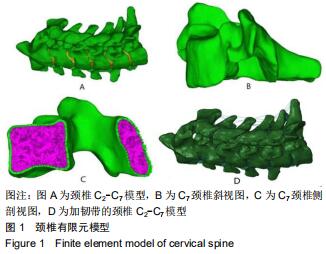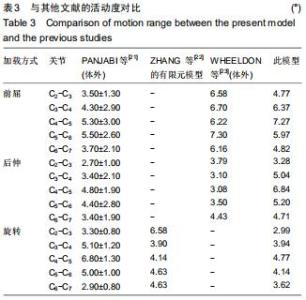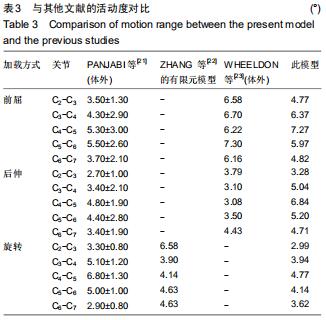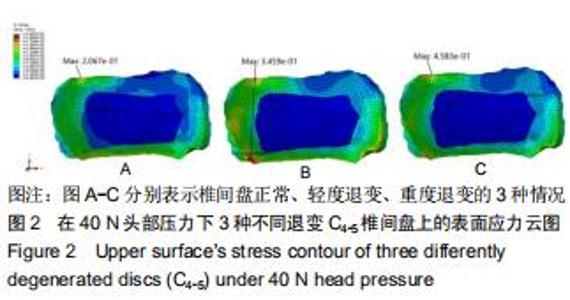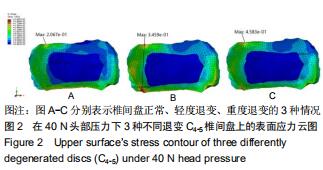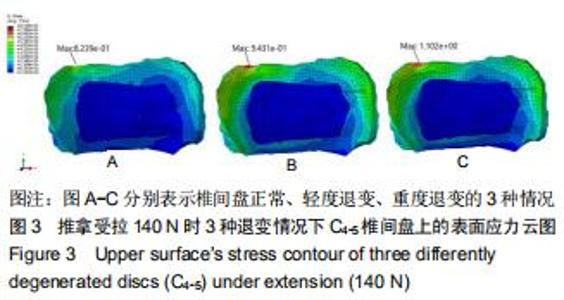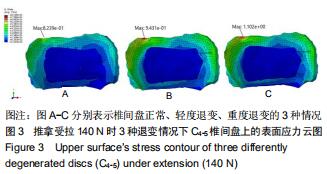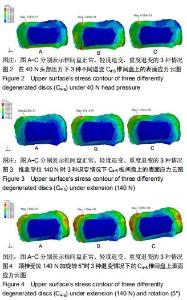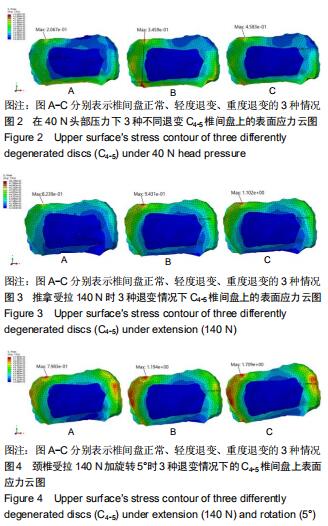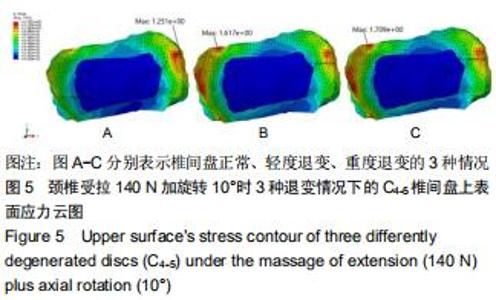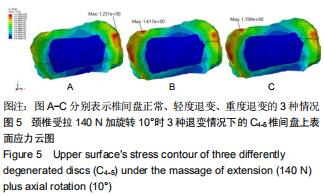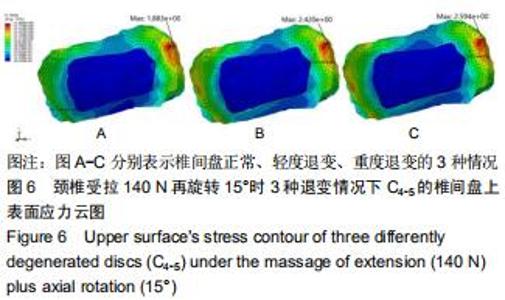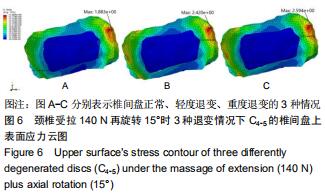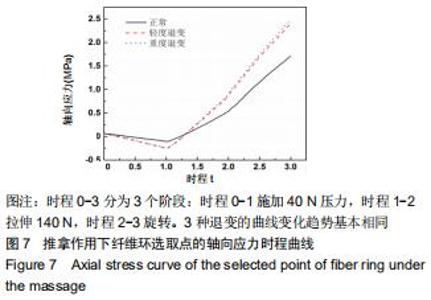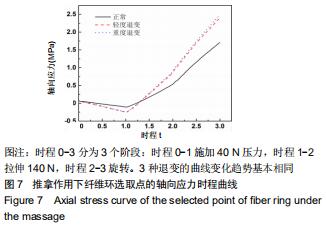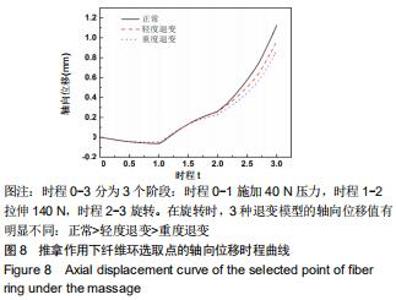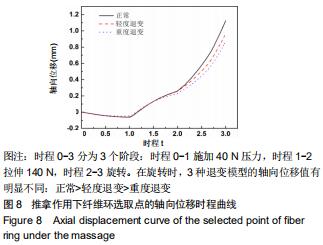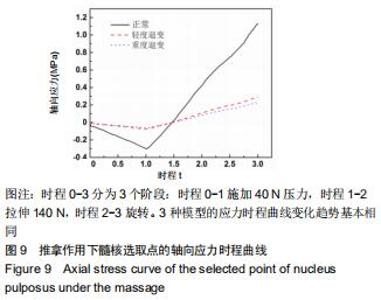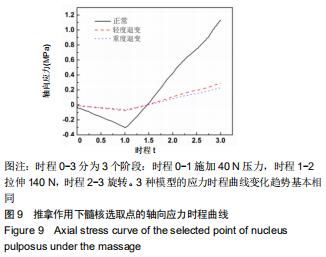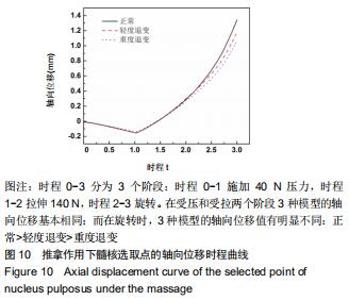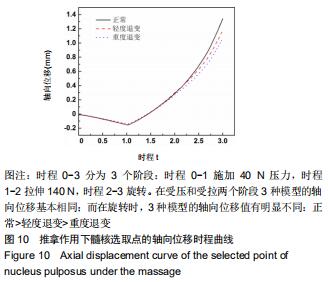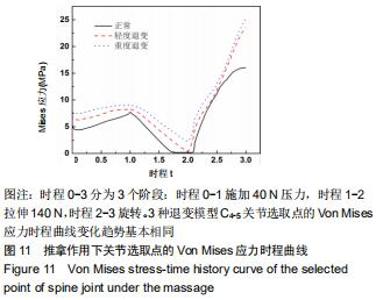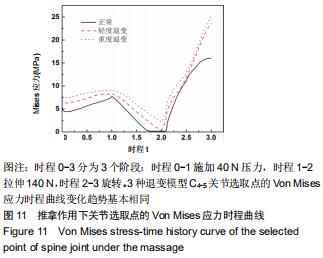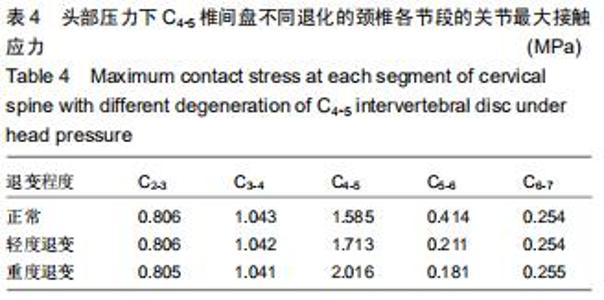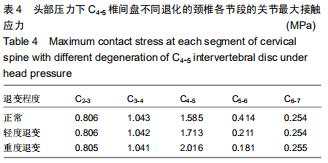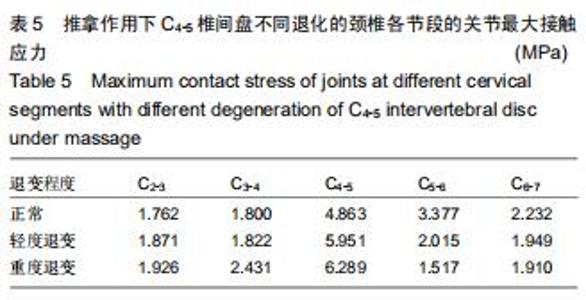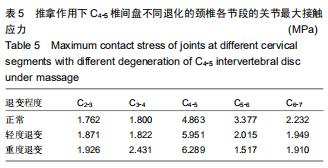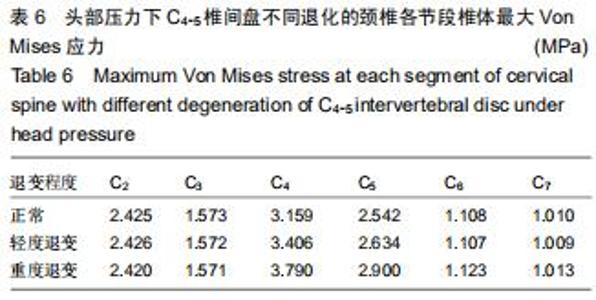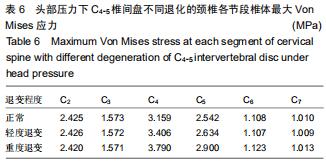Chinese Journal of Tissue Engineering Research ›› 2020, Vol. 24 ›› Issue (27): 4278-4284.doi: 10.3969/j.issn.2095-4344.2774
Previous Articles Next Articles
Finite element analysis of cervical spine (C2-C7) with degenerated disc under normal loading and massage
Wang Yu1, 2, 3, Lei Jianyin1, 2, 3, Xin Hao1, 2, 3, Luo Lin4, Li Zhiqiang1, 2, 3
1Institute of Applied Mechanics, College of Mechanical and Vehicle Engineering, Taiyuan University of Technology; 2Shanxi Key Laboratory of Material Strength and Structure Impact; 3National Demonstration Center for Experimental Mechanics Education (Taiyuan University of Technology); 4Guangdong Second Traditional Chinese Medical Hospital
-
Received:2019-12-03Revised:2019-12-10Accepted:2020-01-18Online:2020-09-28Published:2020-09-05 -
Contact:Luo Lin, Professor, Chief physician, Guangdong Second Traditional Chinese Medical Hospital, Guangzhou 510095, Guangdong Province, China -
About author:Wang Yu, Master candidate, Institute of Applied Mechanics, College of Mechanical and Vehicle Engineering, Taiyuan University of Technology, Taiyuan 030024, Shanxi Province, China; Shanxi Key Laboratory of Material Strength and Structure Impact, Taiyuan 030024, Shanxi Province, China; National Demonstration Center for Experimental Mechanics Education (Taiyuan University of Technology), Taiyuan 030024, Shanxi Province, China -
Supported by:the National Natural Science Foundation of China, No. 81574093
CLC Number:
Cite this article
Wang Yu, Lei Jianyin, Xin Hao, Luo Lin, Li Zhiqiang. Finite element analysis of cervical spine (C2-C7) with degenerated disc under normal loading and massage[J]. Chinese Journal of Tissue Engineering Research, 2020, 24(27): 4278-4284.
share this article
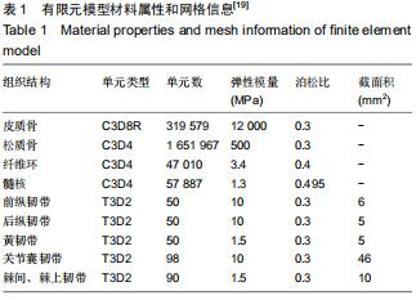
1.4.1 三维有限元模型及退变模型的建立 首先提取几何模型,将Dicom格式的CT断层扫描资料导入Mimics 19.0软件,通过三维重建,得到颈椎C2-7椎体几何模型。将颈椎几何模型导入Hypermesh V13.0中,对网格进行划分、优化最终得到包括皮质骨、松质骨、椎间盘等在内的有限元模型,皮质骨是由面网格向内偏置1.5 mm而成的[16-17],松质骨利用皮质骨的内表面生成,椎间盘(纤维环及髓核)的上下表面分别为上接椎体下表面和下接椎体上表面生成。不同材质的组织间的连接面相同,网格属于流形网格。由于相邻部件在运动中没有相对滑动,因此相邻部件之间采用tie接触。椎间盘包括髓核和纤维环,髓核的体积大约占椎间盘的40%[18],在椎间盘的中间位置,纤维环在髓核的外部并呈环形包裹髓核。最后导入ABAQUS 6.11中,添加了颈椎中的相关韧带,韧带采用一维单元,且设置为只承受拉力。建立接触对,关节面设置面面接触来模拟各关节之间的相对滑动和分离的运动特性,摩擦系数设为0.10[18],皮质骨与松质骨、皮质骨与椎间盘设为绑定约束(Tie),赋予材料参数,材料属性及网格类型见表1。颈椎椎间盘的退变表现为材料性质的改变和几何上的变化[15],此次研究只针对其材料属性的改变进行研究,通过改变C4-5椎间盘中纤维环和髓核的参数创建不同退化程度的椎间盘,创建了C4-5椎间盘不同程度退变的颈椎(C2-C7)模型,具体参数见表2。 "
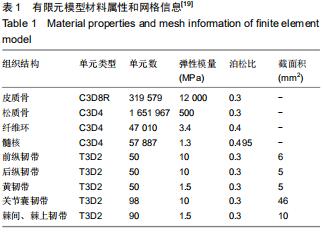
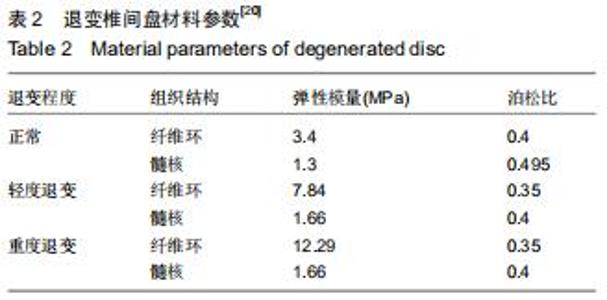
1.4.1 三维有限元模型及退变模型的建立 首先提取几何模型,将Dicom格式的CT断层扫描资料导入Mimics 19.0软件,通过三维重建,得到颈椎C2-7椎体几何模型。将颈椎几何模型导入Hypermesh V13.0中,对网格进行划分、优化最终得到包括皮质骨、松质骨、椎间盘等在内的有限元模型,皮质骨是由面网格向内偏置1.5 mm而成的[16-17],松质骨利用皮质骨的内表面生成,椎间盘(纤维环及髓核)的上下表面分别为上接椎体下表面和下接椎体上表面生成。不同材质的组织间的连接面相同,网格属于流形网格。由于相邻部件在运动中没有相对滑动,因此相邻部件之间采用tie接触。椎间盘包括髓核和纤维环,髓核的体积大约占椎间盘的40%[18],在椎间盘的中间位置,纤维环在髓核的外部并呈环形包裹髓核。最后导入ABAQUS 6.11中,添加了颈椎中的相关韧带,韧带采用一维单元,且设置为只承受拉力。建立接触对,关节面设置面面接触来模拟各关节之间的相对滑动和分离的运动特性,摩擦系数设为0.10[18],皮质骨与松质骨、皮质骨与椎间盘设为绑定约束(Tie),赋予材料参数,材料属性及网格类型见表1。颈椎椎间盘的退变表现为材料性质的改变和几何上的变化[15],此次研究只针对其材料属性的改变进行研究,通过改变C4-5椎间盘中纤维环和髓核的参数创建不同退化程度的椎间盘,创建了C4-5椎间盘不同程度退变的颈椎(C2-C7)模型,具体参数见表2。 "
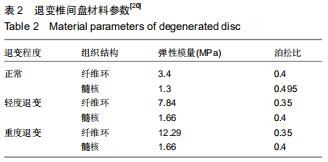
|
[1] 姜广宗,李学锋,聂林,等.利用MIMICS和ABAQUS建立正常人颈椎的三维有限元模型[J].中国矫形外科杂志,2013,21(11): 1114-1120.
[2] 中华外科杂志编辑部. 颈椎病的手术治疗及围手术期管理专家共识(2018)[J].中华外科杂志,2018,56(12):881-884.
[3] 乔秀秀,于秀娟,张蕊杰,等.大学生颈椎病现状调查及防治对策[J].科技资讯,2017,15(29):204-205+207.
[4] 吕艳伟,李文桓,田伟,等.基于不同核函数构建的退行性颈椎病支持向量机高危人群筛查模型的比较[J].中国卫生统计,2018, 35(3):368-371.
[5] 余洋.颈椎病的治疗与护理研究现状[J].海南医学,2018,29(20): 2949-2951.
[6] 罗勇骏,杨海源,唐鹏宇,等.青年人颈椎病的临床特点及前路手术疗效观察[J].中国矫形外科杂志,2017,25(7):583-589.
[7] 陈佳雯,汪慧,董菡珺,等.医务人员常见疾病现状调查分析[J].重庆医学,2018,47(26):3450-3452+3457.
[8] 张琪,金鸿宾,范桐顺,等.推拿手法治疗颈椎病机制研究[J].河南中医,2018,38(8):1248-1251.
[9] LING TH, ZAKARIA AF, ABDULLAH AT. Is neck massage safe? A rare case of tetraplegia and spinal shock after neck manipulation. J Orthop Surg. 2017;25(1):230949901769045.
[10] 刘治华,许伟超,张新民,等.颈椎C2-7三维有限元模型的建立与最优角度牵引仿真研究[J].郑州大学学报(医学版), 2016,51(3): 359-363.
[11] 徐海涛. 腰椎手法推拿力的量化研究和有限元分析[D].广州:南方医科大学,2008.
[12] 邬黎平. 颈椎推拿的作用机理及优化研究[D].广州:南方医科大学,2010.
[13] DENG Z, WANG K, WANG H, et al. A finite element study of traditional Chinese cervical manipulation. Eur Spine J. 2017; 26(7):1-10.
[14] 闫家智,吴志宏,汪学松,等.腰椎间盘退变后应力变化的有限元分析[J].中国医学科学院学报,2009,31(4):464-467.
[15] 王诗成,潘磊,黄必留,等.颈椎间盘退变对颈椎生物力学影响的有限元研究[J].颈腰痛杂志,2015,36(3):175-178.
[16] MUTHUKUMAR N. C1-C3 lateral mass fusion for type IIa and type III Hangman's fracture. J Craniovertebr Junction Spine. 2012;3(2): 62-66.
[17] LEE S, IM Y, KIM K, et al. Comparison of cervical spine biomechanics after fixed-and mobile-core artificial disc replacement:a finite element analysis.Spine.2011;36(9): 700-708.
[18] 苏再发,贾连顺,张美超,等.利用Mimics和Freeform建立下颈椎三维非线性有限元模型[J].脊柱外科杂志,2009,7(4):221-225. [19] 刘海波,雷建银,张宝成,等.前后路内固定治疗Ⅱ型不稳定Hangman骨折的有限元分析[J].医用生物力学, 2015,30(4): 326-331.
[20] 赵亮,闫广华,瞿东滨,等.腰椎间盘退变对软骨终板生物力学特性影响的有限元分析[J].中国临床解剖学杂志,2015,33(4): 455-460.
[21] PANJABI MM, CRISCO JJ, VASAVADA A, et al. Mechanical properties of the human cervical spine as shown by three-dimensional load-displacement curves. Spine. 2001; 26(24):2692-2700.
[22] ZHANG QH, TEO EC, NG HW, et al. Finite element analysis of moment-rotation relationships for human cervical spine. J Biomech. 2006;39(1):189-193.
[23] WHEELDON JA, PINTAR FA, KNOWLES S, et al. Experimental flexion/extension data corridors for validation of finite element models of the young, normal cervical spine. J Biomech. 2006;39(2):375-380.
[24] 曹贵君. ROI-C融合器内固定治疗Hangman骨折有限元分析与临床应用[D].青岛:青岛大学,2017.
[25] 李斌,赵文志,陈秉智.有限元分析:椎间盘退变对颈椎生物力学的影响[J].中国组织工程研究,2017,21(11):1748-1752.
[26] 杜诗尧,周风金,倪斌,等.新型后路寰枢椎限制性非融合内固定系统的有限元分析[J].中国组织工程研究,2017,21(3):383-389.
[27] 蒋诗超,房敏,程英武,等.神经根型颈椎病动物模型国内研究进展及评价[J].中华中医药杂志,2012,27(12): 3052-3056.
[28] DEL PALOMAR AP, CALVO B, DOBLARÉ M. An accurate finite element model of the cervical spine under quasi-static loading. J Biomech. 2008; 41(3):523-531.
[29] JOHN JD, SARAVANA KUMAR G, YOGANANDAN N. Cervical spine morphology and ligament property variations: A finite element study of their influence on sagittal bending characteristics. J Biomech. 2019;85:18-26.
[30] KIM YH , KHUYAGBAATAR B, KIM K. Recent advances in finite element modeling of the human cervical spine. J Mech Sci Technol. 2018;32(1):1-10.
[31] NIKKHOO M, CHENG CH, WANG JL, et al. Development and validation of a geometrically personalized finite element model of the lower ligamentous cervical spine for clinical applications. Comput Biol Med. 2019;109:22-32.
[32] WANG XD, FENG MS, HU YC. Establishment and finite element analysis of a three-dimensional dynamic model of upper cervical spine instability: finite element of upper cervical instability. Orthop Surg. 2019;11(3):500-509.
[33] 刘伟聪,陈雄生,周盛源,等.正常人体C0-T1全颈椎有限元模型的构建及意义[J].中国组织工程研究,2018,22(11):1707-1712.
[34] 陈群响,倪斌,郭群峰,等.带肌肉组织全颈椎三维有限元模型的建立及分析[J].中国脊柱脊髓杂志,2019,29(4):348-355.
[35] 陈威烨,王辉昊,梁飞凡,等.牵引治疗颈椎病的研究进展[J].中国康复医学杂志,2016,31(5):599-601.
[36] 邓真,王辉昊,牛文鑫,等.中医定点旋扳法对颈椎应力作用的有限元分析[A]. 第十二届全国生物力学学术会议暨第十四届全国生物流变学学术会议会议论文摘要汇编,2018.
[37] 王宽,邓真,王辉昊,等.力学测量在评估颈痛及手法治疗领域的应用[J].中国骨伤,2016,29(7):668-672.
[38] 孙树椿,张军,王立恒,等.旋转手法对颈椎髓核内压力影响的实验研究[J].中国骨伤,2010,23(1):34-38. |
| [1] | Xu Feng, Kang Hui, Wei Tanjun, Xi Jintao. Biomechanical analysis of different fixation methods of pedicle screws for thoracolumbar fracture [J]. Chinese Journal of Tissue Engineering Research, 2021, 25(9): 1313-1317. |
| [2] | Jiang Yong, Luo Yi, Ding Yongli, Zhou Yong, Min Li, Tang Fan, Zhang Wenli, Duan Hong, Tu Chongqi. Von Mises stress on the influence of pelvic stability by precise sacral resection and clinical validation [J]. Chinese Journal of Tissue Engineering Research, 2021, 25(9): 1318-1323. |
| [3] | Chen Xinmin, Li Wenbiao, Xiong Kaikai, Xiong Xiaoyan, Zheng Liqin, Li Musheng, Zheng Yongze, Lin Ziling. Type A3.3 femoral intertrochanteric fracture with augmented proximal femoral nail anti-rotation in the elderly: finite element analysis of the optimal amount of bone cement [J]. Chinese Journal of Tissue Engineering Research, 2021, 25(9): 1404-1409. |
| [4] | Zhou Jihui, Li Xinzhi, Zhou You, Huang Wei, Chen Wenyao. Multiple problems in the selection of implants for patellar fracture [J]. Chinese Journal of Tissue Engineering Research, 2021, 25(9): 1440-1445. |
| [5] | Pei Lili, Sun Guicai, Wang Di. Salvianolic acid B inhibits oxidative damage of bone marrow mesenchymal stem cells and promotes differentiation into cardiomyocytes [J]. Chinese Journal of Tissue Engineering Research, 2021, 25(7): 1032-1036. |
| [6] | Yang Weiqiang, Ding Tong, Yang Weike, Jiang Zhengang. Combined variable stress plate internal fixation affects changes of bone histiocyte function and bone mineral density at the fractured end of goat femur [J]. Chinese Journal of Tissue Engineering Research, 2021, 25(6): 890-894. |
| [7] | Song Chengjie, Chang Hengrui, Shi Mingxin, Meng Xianzhong. Research progress in biomechanical stability of lateral lumbar interbody fusion [J]. Chinese Journal of Tissue Engineering Research, 2021, 25(6): 923-928. |
| [8] | Liu Zhao, Xu Xilin, Shen Yiwei, Zhang Xiaofeng, Lü Hang, Zhao Jun, Wang Zhengchun, Liu Xuzhuo, Wang Haitao. Guiding role and prospect of staging and classification combined collapse prediction method for osteonecrosis of femoral head [J]. Chinese Journal of Tissue Engineering Research, 2021, 25(6): 929-934. |
| [9] | Xu Yulin, Shen Shi, Zhuo Naiqiang, Yang Huilin, Yang Chao, Li Yang, Zhao Heng, Zhao Lu. Biomechanical comparison of three different plate fixation methods for acetabular posterior column fractures in standing and sitting positions [J]. Chinese Journal of Tissue Engineering Research, 2021, 25(6): 826-830. |
| [10] | Cai Qunbin, Zou Xia, Hu Jiantao, Chen Xinmin, Zheng Liqin, Huang Peizhen, Lin Ziling, Jiang Ziwei. Relationship between tip-apex distance and stability of intertrochanteric femoral fractures with proximal femoral anti-rotation nail: a finite element analysis [J]. Chinese Journal of Tissue Engineering Research, 2021, 25(6): 831-836. |
| [11] | Zhang Nianjun, Chen Ru. Analgesic effect of cocktail therapy combined with femoral nerve block on total knee arthroplasty [J]. Chinese Journal of Tissue Engineering Research, 2021, 25(6): 866-872. |
| [12] | Xie Chongxin, Zhang Lei. Comparison of knee degeneration after anterior cruciate ligament reconstruction with or without remnant preservation [J]. Chinese Journal of Tissue Engineering Research, 2021, 25(5): 735-740. |
| [13] | Liu Bo, Chen Xianghe, Yang Kang, Yu Huilin, Lu Pengcheng. Mechanism of DNA methylation in exercise intervention for osteoporosis [J]. Chinese Journal of Tissue Engineering Research, 2021, 25(5): 791-797. |
| [14] | Zhang Guomei, Zhu Jun, Hu Yang, Jiao Hongwei. Stress of three-dimensional finite element models of E-MAX porcelain inlay [J]. Chinese Journal of Tissue Engineering Research, 2021, 25(4): 537-541. |
| [15] | Wang Xiaofei, Teng Xueren, Cong Linyan, Zhou Xu, Ma Zhenhua. Herbert screw internal fixation for treating adult osteochondritis dissecans of the knees [J]. Chinese Journal of Tissue Engineering Research, 2021, 25(3): 397-402. |
| Viewed | ||||||
|
Full text |
|
|||||
|
Abstract |
|
|||||
